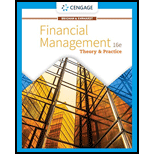
Hager’s Home Repair Company, a regional hardware chain, which specializes in “do-it-yourself” materials and equipment rentals, is considering an acquisition of Lyon Lighting (LL). Doug Zona, Hager’s treasurer and your boss, has been asked to place a value on the target and he has enlisted your help.
LL has 20 million shares of stock trading at $12 per share. Security analysts estimate LL’s beta to be 1.25. The risk-free rate is 5.5% and the market risk premium is 4%. LL’s capital structure is 20% financed with debt at an 8% interest rate; any additional debt due to the acquisition also will have an 8% rate. LL has a 25% federal-plus-state tax rate, which will not change due to the acquisition.
The following data incorporate expected synergies and required levels of total net operating capital for LL should Hager’s complete the acquisition. The

Note:
aDebt is added on the first day of the year, so the 2019 debt is LL’s debt prior to the acquisition.
Hager’s management is new to the merger game, so Zona has been asked to answer some basic questions about mergers as well as to perform the merger analysis. To structure the task, Zona has developed the following questions, which you must answer and then defend to Hager’s board:
Briefly describe the differences between a hostile merger and a friendly merger.
Want to see the full answer?
Check out a sample textbook solution
Chapter 22 Solutions
Financial Management: Theory & Practice
- Hager’s Home Repair Company, a regional hardware chain, which specializes in “do-it-yourself” materials and equipment rentals, is considering an acquisition of Lyon Lighting (LL). Doug Zona, Hager’s treasurer and your boss, has been asked to place a value on the target and he has enlisted your help. LL has 20 million shares of stock trading at $12 per share. Security analysts estimate LL’s beta to be 1.25. The risk-free rate is 5.5% and the market risk premium is 4%. LL’s capital structure is 20% financed with debt at an 8% interest rate; any additional debt due to the acquisition also will have an 8% rate. LL has a 25% federal-plus-state tax rate, which will not change due to the acquisition. The following data incorporate expected synergies and required levels of total net operating capital for LL should Hager’s complete the acquisition. The forecasted interest expense includes the combined interest on LL’s existing debt and on new debt. After 2024, all items are expected to grow at a constant 6% rate. Note: aDebt is added on the first day of the year, so the 2019 debt is LL’s debt prior to the acquisition. Hager’s management is new to the merger game, so Zona has been asked to answer some basic questions about mergers as well as to perform the merger analysis. To structure the task, Zona has developed the following questions, which you must answer and then defend to Hager’s board: Why can’t we estimate LL’s value to Hager’s by discounting the FCFs at the WACC? What method is appropriate? Use the projections and other data to determine the LL division’s free cash flows and interest tax savings for 2020 through 2024. Notice that the LL division’s sales are expected to grow rapidly during the first years before leveling off at a sustainable long-term growth rate.arrow_forwardYour employer, a midsized human resources management company, is considering expansion into related fields, including the purchase of Biggerstaff & McDonand (B&M), a privately held company owned by two friends, each with 5 million shares of stock. B&M currently has free cash flow of $24 million, which is expected to grow at a constant rate of 5%. B&M’s financial statements report short-term investments of $100 million, debt of $200 million, and preferred stock of $50 million. B&M’s weighted average cost of capital (WACC) is 11%. Use B&M’s data and the free cash flow valuation model to answer the following questions: What is the estimated value of operations? What is the estimated total corporate value? (this is the entity value.) What is its estimated intrinsic value of equity? What is its estimated intrinsic stock price per share?arrow_forwardIgnatius Industries is considering going public but is still determining a fair offering price for the company. Before hiring an investment banker to assist in making the public offering, managers at Ignatius have decided to make their own estimate of the firm’s common stock value. The firm’s CFO has gathered data for valuating using the free cash flow valuation model. The firm’s weighted average cost of capital is 12%, and it has $1,500,000 of debt at market value and $550,000 of preferred stock at its assumed market value. The estimated free cash flows over the next 5 year, 2024 through 2028, are given below. Beyond 2028 to infinity, the firm expects its free cash flow to grow by 3% annually. Year FCF 2024 $250,000 2025 325,000 2026 810,000 2027 950,000 2028 1,690,000 Estimate the value of Ignatius Industries’ entire company by using the free cash flow valuation model. Use your finding in part a, along with the data provided…arrow_forward

 Intermediate Accounting: Reporting And AnalysisAccountingISBN:9781337788281Author:James M. Wahlen, Jefferson P. Jones, Donald PagachPublisher:Cengage Learning
Intermediate Accounting: Reporting And AnalysisAccountingISBN:9781337788281Author:James M. Wahlen, Jefferson P. Jones, Donald PagachPublisher:Cengage Learning EBK CONTEMPORARY FINANCIAL MANAGEMENTFinanceISBN:9781337514835Author:MOYERPublisher:CENGAGE LEARNING - CONSIGNMENT
EBK CONTEMPORARY FINANCIAL MANAGEMENTFinanceISBN:9781337514835Author:MOYERPublisher:CENGAGE LEARNING - CONSIGNMENT Intermediate Financial Management (MindTap Course...FinanceISBN:9781337395083Author:Eugene F. Brigham, Phillip R. DavesPublisher:Cengage Learning
Intermediate Financial Management (MindTap Course...FinanceISBN:9781337395083Author:Eugene F. Brigham, Phillip R. DavesPublisher:Cengage Learning




